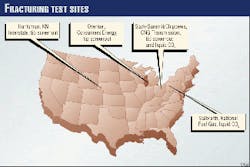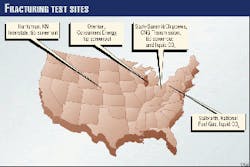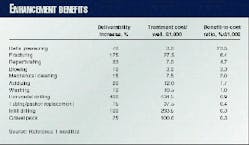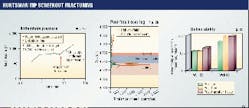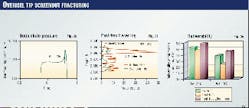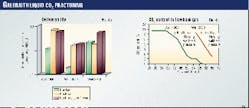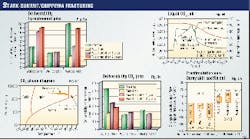GAS STORAGE DELIVERABILITY-2
Tip-screenout and liquid CO2 with proppant fracturing treatments can both be highly effective for deliverability enhancement in gas storage wells. Each, however, has distinct advantages and disadvantages.
This second of a four-part series (Part 1 is in OGJ, Nov. 15, 1999, p. 43) discusses the results of a DOE project that investigated these two fracturing methods.
Tip-screenout is perhaps the most familiar technique and is cost effective, although the introduction of significant water volumes to the storage horizon may require years to clean up. Precautions must also be used to avoid uncontrolled fracture-height growth.
Gas-storage formations are often highly sensitive to any amount of aqueous liquids, which apparently act to reduce temporarily near-wellbore permeability to gas. Nonaqueous stimulation fluids, such as liquid CO2, seem to provide more immediate stimulation benefits without a prolonged fluid cleanup time.
Treatment study
Gas storage wells present some special challenges such as their extreme sensitivity to the introduction of aqueous fluids. To address these obstacles and challenges, the DOE tested tip-screenout fracturing and fracturing with liquid CO2 and proppant in several gas storage fields across the US (Fig. 1).
DOE selected the tip-screenout technique because it can create high-conductivity fractures, an important consideration for effectively stimulating high-permeability formations. The liquid CO2 with proppant method was selected for its non-aqueous nature, thus addressing the fluid sensitivity of gas storage reservoirs.
Tip screenout
Tip screenout was the primary fracturing technique at two test sites: the Huntsman storage field in Cheyenne County, Neb., operated by KN Interstate Gas Transmission Co., Denver, and the Overisel storage field in Allegan County, Mich., operated by Consumers Energy Co., Jackson, Mich.
Huntsman Wells HS-23 and HS-45 were fractured in spring 1996 and 1997, respectively.
In the storage horizon, the third Dakota J Sand, permeability varied from 45 to more than 800 md. Prefrac testing indicated that several wells had severe skin damage that limited performance. The high permeability and high skin indicated a good potential for improving Huntsman deliverability.
The primary concern, however, was maintaining caprock integrity because the overlying Huntsman shale is only 50-ft thick and permeable sands lie above it. To ensure the control of fracture height growth, the tests included mini-fracs tagged with a radioactive tracer to validate the job design.
The wells were fractured in spring, near the minimum reservoir pressure of the annual gas-storage cycle. This maximized the contrast of in situ stresses between formation layers and helped further to contain the vertical extension of the fractures.
Both stimulations were successful. The jobs achieved tip screenouts with contained fracture height growth and significantly improved deliverability (Fig. 2).
Note that in Well HS-23, with a 45-md permeability, a significant improvement in deliverability was observed only after 1 year of cleanup. In the case of Well HS-45, with a 700-md permeability, an immediate deliverability response was observed. This may indicate that wells with higher permeability may be somewhat less fluid sensitive than lower permeability wells.
The Overisel well's storage horizon, fractured in spring 1997, is the Silurian A-2 dolomite with a test permeability ranging from 5 to 18 md. Prestimulation well skin factors ranged from +3 to -2, indicating remnants of the 1950s vintage hydraulic fracture treatments
The first two stimulations, Wells O-214 and O-240, were pumped as designed. Bottomhole pressure data collected during these treatments, however, indicated that tip screenout did not occur. Proppant selection may have contributed to this.
The proppant in the lead slurry was 40/60-mesh sand, followed by 20/40 sand. This design anticipated possible natural reservoir fractures that would adversely affect fluid leakoff.
This proppant selection may have made tip screenout more difficult. Fracture height growth into low fluid-loss zones could not be arrested with the smaller proppant, hence, tip screenout was prevented.
In the third well, O-205, the lead slurry contained 20/40 sand followed by 12/20 sand. This treatment screened out after placing about 50% of the 40,000 lb of sand called for in the job design. Nevertheless, bottomhole treating pressures and radioactive tracer logs (Figs. 3a and 3b) indicated a well-contained fracture with a 3,000 md-ft conductivity.
The radioactive tracer survey indicated proppant coverage across the entire storage reservoir without the uncontrolled fracture height experienced in the first two wells. Fig. 3c shows resulting deliverabilities for Wells O-240 and O-205.
Well O-214 has only recently had sand cleaned out, and further well testing is needed. It is worth noting that, in this case, the deliverability declined immediately following the treatment and improved after a year of cleanup.
Perhaps consistent with the results from the Huntsman field, the lower permeability at Overisel (5-20 md) may have influenced the reservoir sensitivity to aqueous fracturing fluids.
Liquid CO2
Liquid CO2 with proppant fracturing techniques were tested, in fall 1995, in three wells in the Galbraith field, Jefferson County, Pa., operated by National Fuel Gas Co., Buffalo, NY. This technique was selected based on observed successful hydraulic fracturing in other wells in the field but also because of the long cleanup times, more than 10 years, as indicated by single-point deliverability testing.
Prestimulation testing of the candidate wells revealed higher than expected permeability, up to 520 md, and high skin damage, indicating that these wells were good candidates for fracturing.
All three jobs pumped less than the designed amount of sand before screening out, less than 5,000 lb in each case. This was attributable to the high permeability, implying high fluid loss with an already low-efficiency fracturing fluid, and a high frac gradient that prevented pumping at the designed rate, thus exacerbating the fluid-loss problem.
Nevertheless, dramatic deliverability improvement occurred. Fig. 4a shows that improvement was immediate in Wells 4886 and 4936, and the improvement in all wells was sustained 1 year later. This demonstrates a significant advantage of liquid CO2 over aqueous fluid stimulations that can require years to achieve full effectiveness.
One concern with fracturing with liquid CO2 was the potential for contaminating the pipeline-quality gas stored in the reservoir. But careful measurements of CO2 content in the cleanup flows showed that the wells were nearly free of CO2 within 72 hr after the job (Fig. 4b).
TSO vs. liquid CO2
The Stark-Summit/Chippewa gas storage field in Ohio provided a unique opportunity to make a side-by-side comparison of TSO vs. liquid CO2 with proppant fracturing.
The Silurian age Clinton sand storage horizon has a test permeability of 2-32 md. All wells at Stark Summit have been previously fractured, and some wells have been fracture stimulated several times.
Operator CNG Transmission Corp., Clarksburg, W.Va., maintains an ongoing fracturing program in this large field in an effort to sustain deliverability. The challenges at this test site were in candidate selection and developing treatment designs to improve performance over the existing fractured condition.
To select candidate wells for fracturing, 25 wells had pressure transient tests taken. It was discovered that almost all wells had a near-zero or negative skin, but analysis of the multipoint test data showed that non-Darcy flow effects were significant. Deliverability improvement would therefore rely on incremental skin reductions and minimizing non-Darcy flow effects.
Wells SS-2471, SS-2571, and SS-1885 were fractured in September 1997. The first two treatments suffered premature screenout at the 5-ppg sand concentration stage, in part due to near-wellbore restrictions.
But design improvements allowed the second treatment to place nearly all of the designed 41,000 lb of proppant. The third well, SS-1885, was re-perforated prior to treatment and its entire job was pumped according to design.
Again, an immediate decline in deliverability is observed following the treatments, with improvement occurring after a minimum of 1 year of cleanup (Fig. 5a). In the case of SS-1885, deliverability still has not reached the prestimulation level after 2 years.
In the Stark Summit/Chippewa field, wells were also fractured with liquid CO2. In fall 1997, CNG stimulated Well C-2557, not in the DOE project, and donated the data to the project to allow for a technical comparison. In fall 1998, two additional wells, C-1874 and C-2417, were similarly fractured.
In all three cases, as at Galbraith, placement of sand in the formation was significantly less than the design called for, about 13,000 lb for C-2557 and less than 3,000 lb for each of the other two wells.
One interesting aspect was that the first bottomhole treatment record for a liquid CO2 fracture stimulation was recorded in well C-1874 (Fig. 5b). Pressure and temperature gauges set in the water column immediately below the perforations obtained measurements that answered a lingering uncertainty about CO2 phase behavior after it had been pumped into the reservoir.
Fig. 5c shows that, for Stark Summit reservoir conditions, CO2 remains liquid during the job and most of the flowback period. It possibly vaporizes only after returning to the wellbore and starting its flow back to surface. The rigorous prefrac design combined with post-frac modeling has advanced the understanding of the liquid CO2 fracturing process and has created a basis for continued applied research in the use of liquid CO2 as a damage remediation method.
Fig. 5d shows post-stimulation deliverability results. Contrary to results at Galbraith, the deliverability changed slightly, in fact it decreased in two wells. Prestimulation non-Darcy skin components shed light on these results (Fig. 5e).
In wells where high non-Darcy skins existed, non-Darcy coefficient (D) > 0.3 Mcfd x10-3, treatments provided a real deliverability enhancement. But in wells where non-Darcy skins were already low (D < 0.3 Mcfd x10-3), the pumping of another treatment may have actually displaced some existing proppant, hence reducing deliverability.
The Authors
Michael B. Smith is president of NSI Technologies Inc., Tulsa. He has over 20 years' experience in rock mechanics, well completions, and hydraulic fracturing, with a major operator and as a consultant.
Smith authored two chapters in the SPE monograph, Recent Advances in Hydraulic Fracturing.
Ramon P. Harris Jr. is an engineer in the gas storage department of National Fuel Gas Co., Buffalo, NY. He supervises operations and engineering for the company's 33 gas storage fields.
Before joining National Fuel, Harris was a senior storage engineer with Columbia Gas Transmission. He holds a BS in petroleum and natural gas engineering from Penn State University.
Ralph Herberg is a senior engineer for Consumers Energy Co., Jackson, Mich. He has 18 years of experience in the gas storage industry with responsibilities including logging, well and field deliverability, field pressure surveys, and drilling.
Herberg holds a BS in geological engineering from Michigan Technological University.
Jim Weber is senior reservoir manager for Kinder Morgan Inc. (formerly KN Energy), in Denver. Weber holds a BS in petroleum engineering from the Colorado School of Mines.
Dan Wood is a senior engineer with CNG Transmission Co., Canton, Ohio. He previously was a production engineer with Marathon Oil Co. and a district engineer with Belden & Blake Corp. Wood holds a BS in petroleum engineering from Marietta College, Ohio.
